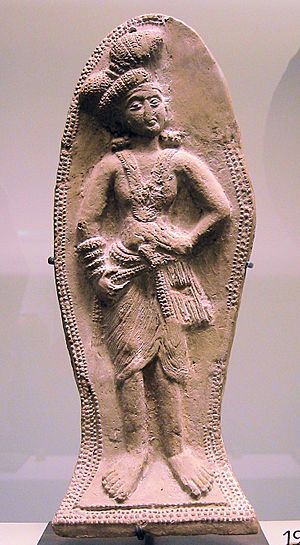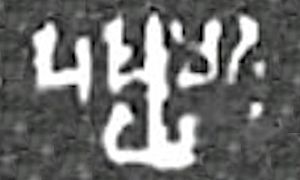Pushyamitra Shunga facts for kids
Quick facts for kids Pushyamitra Shunga |
|
|---|---|

A figure from the Sunga period
|
|
| Shunga Emperor | |
| Reign | c. 185 – c. 149 BCE |
| Predecessor | Brihadratha Maurya (as Mauryan Emperor) |
| Successor | Agnimitra |
| Issue | Agnimitra |
| Dynasty | Shunga |
| Religion | Hinduism |
Pushyamitra Shunga (ruled around 185 to 149 BCE) was a very important ruler in ancient India. He helped start the Shunga Empire. He became emperor after the Maurya Empire ended. His original name might have been Pushpaka or Pushpamitra.
Pushyamitra is known for performing many special ceremonies called Ashvamedhas. These were horse sacrifices that showed his right to rule. His empire stretched far, with records found in places like Ayodhya. Some old texts also say his empire reached as far as Sakala (today's Sialkot) in the northwest.
Some old Buddhist writings claim that Pushyamitra was mean to Buddhists. However, many modern experts do not agree with these claims.
Contents
Pushyamitra Shunga: Was He Against Buddhists?
Stories from Buddhist Texts
Some ancient Buddhist writings say that Pushyamitra was cruel to Buddhists. One of the oldest stories is from a text called Ashokavadana, written around 200 CE. This story says Pushyamitra wanted to be famous. His advisors told him he couldn't be as famous as Ashoka, who built many Buddhist stupas (dome-shaped shrines).
So, an advisor suggested he could become famous by destroying Buddhism. The story claims Pushyamitra tried to destroy a monastery in Pataliputra. Later, he went to Shakala and offered a reward for every head of a Buddhist monk.
Another old text, Vibhasa, says Pushyamitra burned Buddhist books. It also claims he killed monks and destroyed many monasteries in Kashmir. The story says a goddess killed him near the Bodhi Tree for his actions.
A Tibetan historian named Taranatha also wrote in the 16th century that Pushyamitra destroyed monasteries. These stories suggest he tried to wipe out Buddhist teachings from northern India.
Are These Stories True?
Based on these Buddhist stories, some historians thought Pushyamitra did persecute Buddhists. But others believe the Buddhist writers might have been unfair to him. This is because he did not support them as much as previous rulers.
Some archaeologists have found signs of damage to Buddhist sites. For example, damage at Takshashila and Sanchi stupa might have happened around Pushyamitra's time. This could support the idea of some conflict.
However, other historians are doubtful about the Buddhist claims. They point out that the stories are not always the same. For instance, they disagree on where Pushyamitra's anti-Buddhist actions happened. Also, one story mentions Roman coins that were not common in India until much later.
Historians also note that Ashoka's own writings show he was tolerant of all religions. This makes some doubt the stories that claim Pushyamitra persecuted Buddhists just because he was a Brahmin.
Also, a play called Malavikagnimitra mentions a Buddhist nun at Pushyamitra's court. This would suggest he was not persecuting Buddhists.
Many modern historians, like Romila Thapar, say there is no strong proof from archaeology that Pushyamitra truly persecuted Buddhists. It's possible that Buddhist influence simply became less important during his rule. They might have stopped getting royal support, which could have led to these exaggerated stories.
Who Ruled After Pushyamitra?
Pushyamitra Shunga was followed by his son, Agnimitra, who became ruler in 148 BCE.
Pushyamitra in Books
The story of Pushyamitra Shunga is mentioned in a book called Harshacharita by Bāṇabhaṭṭa. Another old text, Vicarasreni, says Pushyamitra became king in 204 BCE.
See also
 In Spanish: Púsiamitra Shunga para niños
In Spanish: Púsiamitra Shunga para niños


